Sorrow can be alleviated by good sleep, a bath and a glass of wine.
– Thomas Aquinas
Wine, a captivating beverage enjoyed by people around the world, has a rich history dating back thousands of years. It is a product of the fermentation of grape juice, transformed into an exquisite elixir through the intricate processes of viticulture and winemaking.
The origins of wine can be traced to ancient civilizations such as the Greeks, Romans, and Egyptians, who revered it for its cultural, social, and religious significance. Today, wine is not only a symbol of celebration and refinement but also a fascinating field of study and a vast industry.
Wine is produced from various grape varieties, each contributing its unique flavours, aromas, and characteristics. Red wine is made from dark-coloured grapes, with the skin left during fermentation to extract tannins and pigments, while white wine is typically produced from green or yellow grapes, with minimal skin contact. Rosé wine falls somewhere in between, with limited skin contact.
Winemaking involves a series of meticulous steps, including harvesting the grapes, crushing, fermentation, ageing, and bottling. The resulting wines can be categorized into different styles, ranging from light and fruity to bold and full-bodied, influenced by factors such as grape variety, climate, soil, and winemaking techniques.
Appreciating wine involves engaging the senses, as its aroma, taste, colour, and texture intertwine to create a memorable experience. Wine enthusiasts explore diverse grape varieties, regions, and vintages, developing a discerning palate and expanding their knowledge.
Whether enjoyed on its own or paired with food, wine invites individuals to embark on a sensory journey, discovering the nuances of flavours and the captivating stories behind each bottle. Its allure continues to captivate and inspire, making wine an integral part of cultures and celebrations worldwide.
When was Wine First Created?
 No one can be sure, but there is an ancient Persian fable that recognises a woman as the discoverer of wine. According to the fable, she was a princess in Persepolis who had lost favour with the King. The shame was so overwhelming that she drank the juice of some table grapes that had spoiled in their jar in an attempt to end her life.
No one can be sure, but there is an ancient Persian fable that recognises a woman as the discoverer of wine. According to the fable, she was a princess in Persepolis who had lost favour with the King. The shame was so overwhelming that she drank the juice of some table grapes that had spoiled in their jar in an attempt to end her life.
Her suicide did not go as planned – instead of slipping into eternal slumber, she got giddy, intoxicated and then passed out. When she awoke she found all the troubles of her life seemed to have passed. She took her discovery to the King, who was so enamoured with the fermented grape drink that he accepted her back in his favour. The city of Shiraz, near the location of this legend, became significant in Persian wine production.
Although this is a pleasant tale, the accidental discovery of wine probably happened a few times in different regions, but what is for sure is the invention of wine is down to pure dumb luck.
Origins of Wine:
The origin of wine is a matter of debate, but the earliest evidence of wine production dates back to 6,000 BC in the Caucasus region, which is now part of Georgia. Archaeologists have found evidence of wine production in the form of grape seeds, wine presses, and wine jars.
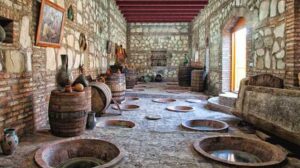 Georgia is generally considered the ‘cradle of wine’, as archaeologists have traced the world’s first known wine creation back to the people of the South Caucasus in 6,000 BC. These early Georgians discovered grape juice could be turned into wine by burying it underground for the winter. Some of the qvevris they were buried in could remain underground for up to 50 years.
Georgia is generally considered the ‘cradle of wine’, as archaeologists have traced the world’s first known wine creation back to the people of the South Caucasus in 6,000 BC. These early Georgians discovered grape juice could be turned into wine by burying it underground for the winter. Some of the qvevris they were buried in could remain underground for up to 50 years.
The Fertile Crescent, located in modern-day Iran, Iraq, Lebanon, Syria, Jordan, Israel, and Palestine, was an area rich in natural resources and ideal climatic conditions for grape cultivation. The wild Eurasian grapevine, Vitis vinifera, is believed to have originated in this region.
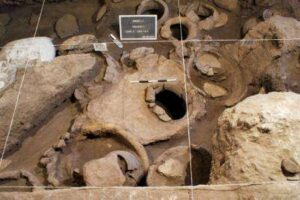 Archaeological evidence points to the Neolithic period (around 8500-4000 BCE) as the time when humans first began domesticating wild grapevines and experimenting with winemaking. The discovery of ancient pottery jars in various archaeological sites, such as Hajji Firuz Tepe in Iran and Areni-1 cave in Armenia, revealed remnants of wine residue dating back to this period.
Archaeological evidence points to the Neolithic period (around 8500-4000 BCE) as the time when humans first began domesticating wild grapevines and experimenting with winemaking. The discovery of ancient pottery jars in various archaeological sites, such as Hajji Firuz Tepe in Iran and Areni-1 cave in Armenia, revealed remnants of wine residue dating back to this period.
 It is believed that wine production spread from the Caucasus region to other parts of the world, including Greece, Italy, and France. Wine became an important part of the culture and religion of many ancient civilizations. In Greece, for example, wine was associated with the god Dionysus, who was the god of wine, festivity, theatre, and madness.
It is believed that wine production spread from the Caucasus region to other parts of the world, including Greece, Italy, and France. Wine became an important part of the culture and religion of many ancient civilizations. In Greece, for example, wine was associated with the god Dionysus, who was the god of wine, festivity, theatre, and madness.
Wine production continued to develop throughout the Middle Ages and the Renaissance. In the 16th century, the Spanish brought wine to the Americas, and wine production soon spread to other parts of the world.
History of Wine in India:
The history of wine in India dates back thousands of years, with evidence of winemaking and grape cultivation found in ancient texts and archaeological discoveries. Wine has been an integral part of India’s cultural and religious traditions.
Regarding the first wines of India, historians believe that these early plantings were used mostly for table grapes or grape juice rather than the production of an alcoholic beverage. Wine may have been a popular beverage during the Vedic period, which spanned the 2nd and 1st millennia. The tribes in the area were well-known for their indulgence in intoxicating beverages. The Vedas, a religious text, mention at least one alcoholic beverage that may have been related to wine: sura, which appears to have been a type of honey-fermented rice wine. The principal known notice of grape-based wines was in the late fourth century BC compositions of Chanakya who was the central clergyman of Sovereign Chandragupta Maurya. Chanakya chronicles the emperor’s and his court’s frequent consumption of Madhu, a type of grape wine, in his writings while condemning alcohol consumption.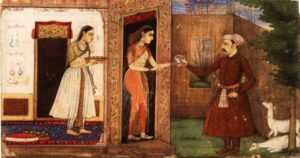
In the centuries that would follow, wine became the privileged drink of the Kshatriya or dominant class while the oppressed caste typically drank alcohol made from wheat, barley and millet. Under the rule of the Muslim Mughal Empire, alcohol was prohibited per Islamic dietary laws. However, there are written reports about at least one Mughal ruler, Jahangir and Babur for example, who were fond of wine. In the 16th century, Portuguese colonists at Goa introduced port-style wine and the production of fortified wines soon spread to other regions. Under British rule during the Victorian era, viticulture and winemaking were strongly encouraged as domestic sources for the British colonists. Vineyards were planted extensively throughout the Baramati, Kashmir and Surat regions. In 1883 at the Calcutta International Exhibition, Indian wines were showcased to a favourable reception. The Indian wine industry was reaching a peak by the time the phylloxera epidemic made its way to the country and devastated its vineyards.
It was a drawn-out, difficult experience for the Indian wine industry to recuperate from the destruction toward the finish of the nineteenth hundred years. The prohibition of alcohol in many of India’s states in the 1950s sparked unfavourable religious and public opinion. Grape plantations were either removed or urged to switch over completely to table grape and raisin creation. The wine was still made in some places, like Goa, but it was usually very sweet and high in alcohol. The establishment of The Tonia Group in the state of Goa in the early 1980s marked the turning point in the modern Indian wine industry. The Tonia Group started making still and sparkling wines by importing Vitis vinifera grape varieties like Cabernet Sauvignon, Chardonnay, Pinot blanc, Pinot noir, and Ugni blanc with help from French winemakers. The emergence of India’s expanding middle class fueled the expansion and development of the Indian wine industry, prompting the establishment of additional wineries.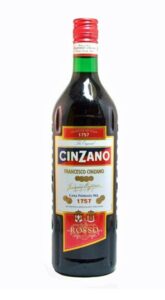
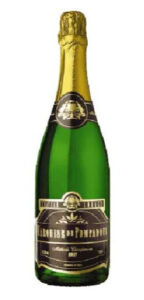 Wine creation continued in India in 1986 with the starting of Marquise De Pompadour produced using the Vitis Vinifera grapes. Sham Chougule of Indage was the first person to make genuine wines. In addition to Chateau Indage, Rajeev Sawants’ “Sula Vineyards” and Kanwal Grover’s “Grover Vineyards” entered the domestic winemaking industry and established numerous additional vineyards throughout the county. To get back the underlying foundations of wine India, Rajeev Sawant got back Vittal Mallya’s Cinzano the year 1996.
Wine creation continued in India in 1986 with the starting of Marquise De Pompadour produced using the Vitis Vinifera grapes. Sham Chougule of Indage was the first person to make genuine wines. In addition to Chateau Indage, Rajeev Sawants’ “Sula Vineyards” and Kanwal Grover’s “Grover Vineyards” entered the domestic winemaking industry and established numerous additional vineyards throughout the county. To get back the underlying foundations of wine India, Rajeev Sawant got back Vittal Mallya’s Cinzano the year 1996.
Some of India’s finest wines are produced by these three wineries. Sula produces popular Chenin Blanc and Sula Shiraz, while Grover Vineyards is known for its Cabernet Sauvignon and Bourdeaux-style blends. Nashik and the Nandi Hills are the best places to grow wine, with numerous vineyards sprouting up all over the country.
The Indian wine industry is still in its early stages, but it has the potential to become a major player in the global wine market. The country has a favourable climate for grape growing, and there is a growing demand for wine among the Indian middle class.
Today, wine is produced in over 100 countries around the world. There are many different types of wine, each with its unique flavour and aroma. Wine is enjoyed by people of all ages and cultures, and it is often used to celebrate special occasions.
Here are some of the most important events in the history of wine:
- 6,000 BC: Earliest evidence of wine production in the Caucasus region
- 4,000 BC: Wine production begins in Greece
- 3,000 BC: Wine production begins in Italy
- 2,000 BC: Wine production begins in France
- 1,600 BC: Wine production begins in Spain
- 1,500 BC: Wine production begins in Portugal
- 1,000 BC: Wine production begins in China
- 500 BC: Wine production begins in India
- 1 AD: Wine production begins in the Americas
- 1500 AD: Wine production begins in Australia
- 1600 AD: Wine production begins in New Zealand
- 1700 AD: Wine production begins in South Africa
- 1800 AD: Wine production begins in Chile
- 1900 AD: Wine production begins in Argentina
- 2000 AD: Wine production begins in South Korea

Wine is a complex and fascinating beverage with a long and storied history. It is enjoyed by people all over the world, and it is sure to continue to be popular for many years to come.


